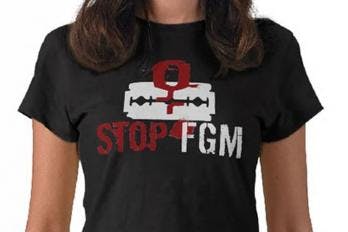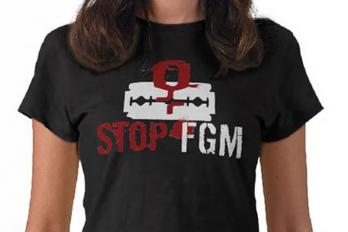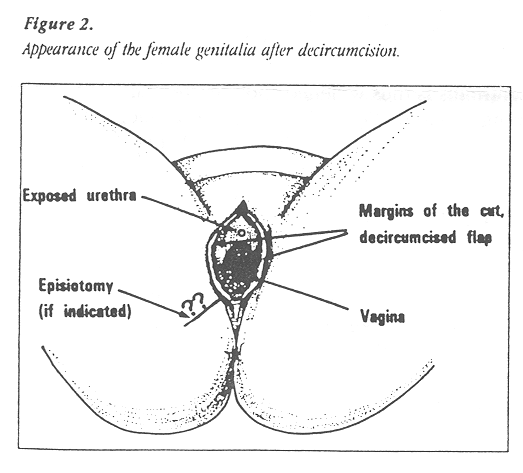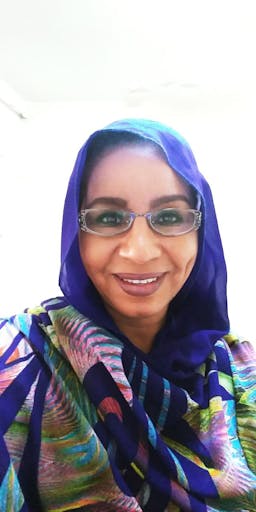Female Genital Mutilation, Marriage And Delivery Personal Accounts!
May 13, 2019
Story




Female Genital Mutilation, is what I believe, one of the most barbaric and disgusting acts to ever be committed against a woman’s free will. It is the most pervasive type of physical and psychological gender based violence (GBV). It is an evil muscle flexing enforcement of men’s sexual authority, and a border line that draws the limit to where a woman’s social mobility ends.
This plague however, is eliminable with unanimous decision, transformative approaches, strong advocacy and patience.
In my article” A Future without Female Genital Mutilation”, published on 2009, on Pulse Wire/ World Pulse platform, I recalled my personal story with that ordeal. This time I will try to shed light on difficulties facing married circumcised woman.
Sharing the pain!
Despite the passage of twelve years, the scene still remains vivid in my memory. From the moment the horrendous experience has begun, and until the last day of your life, it will never cease to torment you. I will never forget the faint sound of the scissor cutting my flesh four times, the stitching four times or relative hideous pain in urination or retention, the accompanying complications and the nightmares of vicious cycle of cutting-stitching-cutting and legacy of hereditary pain.
I remember very well the day when I was rushed to a large public hospital in one of the Gulf countries. I was in intense transition labor, where my cervix was 10C dilated, and my baby was stuck for half an hour in the delivery canal. If not for FGM/C, I could have delivered my daughter at home or while I was on my way to hospital, but I needed help to be deinfibulated and allow the baby go out. It was performed without anesthesia, and was done with the help of a nurse. My suffocating baby was rushed to a nearby vacuum extraction. I was panicked and my body started violently shaking. My blood pressure was high, and I was trapped too in post-maternity complication.
A catheter was inserted into my cavity to help urinate. All that time the Placenta was still left inside me. From between my clicking teeth I murmured “on my dead body shall my daughter be excised”.
Painful stitching and more
Stitching was phase two in the series of cutting –stitching-cutting. Oh, I forgot to mention episiotomy which a surgical incision is made three times to enlarge the vaginal opening to help deliver a baby. This is an eternal journey of suffering and complications.
Lying down on that white labor table, I wept silently when I heard another laboring Sudanese pleading to her doctor to help reopen her and take “that thing” out, referring to her baby. I was ashamed and embarrassed to have my mutilation seen by a male doctor, and prayed that it never happens. But it did. The scene is still imprinted in my mind. It was 3.30 P.M. on a cold Thursday in February 2001. A male doctor, a female nurse and I were in the emergency suite. The three of us were foreigners; each one of us from a different nationality; Asian, Arab, and I, Sudanese. The placenta was pulled away from me and thrown in the garbage without being calculated. A piece was left inside me and stayed there for five days poisoning my blood and threatening my existence. I recovered after having my Uterus corrugated and given strong antibiotics for a week or so. But that is another story.
Let us go back to the stitching. Having seen a long needle with a curved head in his hand, my heart beat pummeled with rapid great force, my breaths matched the rapidness of my heart’s pounding and my face became soaked in sweat and tears. I was a prey to anxiety and stress and felt like shaking inside all over. Trauma memories of childhood experience came back to me. Another image of Hajja Zeinab, the midwife who cut me as I described in my article given above replaced the doctor.
I was afraid that my body might fail me and resist numbing as habitual, so I volunteered to tell the doctor that I was Anesthetic resistant. But there was no response from him. He was cool. He asked the nurse to handle him a needle. When she approached him, she had a look on my open wound. Her eyes popped wide open and lower jaw dropped in an aghast manner which she didn’t even bother hiding. I could see it from behind her muzzle. I felt a deep rage, accompanied by anger, shame, grief, low-self-esteem, depression, pain, and disgrace, but didn’t utter a word.
The horrified look on the nurse’s face when she saw my open wound, had communicated an interrogative message to me: “WHY?”; a question that I repeated helplessly for decades.
A sudden crucifying injection with suturing thread moving inside one of the lips of my fresh wound brought me violently back to reality. The pain was beyond ability. I screamed at the top of my lungs, and, with sobbing and trembling faint voice, begged him to give me more anesthetic. But he wasn’t listening; instead he advised me not to repeat the same practice to my daughter who was lying helplessly not far from me.
“I wish I had given a choice later rather than to be forced into this operation when I was too young to accept or reject or resist”, I muttered, but that statement fell on deaf ears as he was hurrying to finish the unpleasant job.
“Stop it, stop it!”, I cried at the top of voice, blinded by anger and pain, sprang up, like a mad woman and in a hasty angry move, took of the Carniola, the matching band and threw it on the floor and stood up determining to leave the hospital.
“Please sit down! It is dangerous to move this way. Let me finish stitching this wound and transfer you to a delivery ward where you can feed your baby”, adding “Don’t you know that you have just had a fast delivery and that your blood pressure was high?” said the doctor.
A cold chill went down my backbone. He yielded, and gave me two more injections. With frowning eye brows and tightly closed lips, he had finished the job quickly as if he was dealing with a dusty bag of maize and handled the needle from over his shoulder to the nurse, inserted his middle finger in my anus to check for the safety of the muscles around it and left. For 45 days the suture remained in my wound before it was completely dissolved and absorbed by my body. Please don’t ask about the anesthetic surgery.
In the ward, I abstained, for six hours, from eating or drinking fluids out of fear not to pass urine and stool as habitually, though I was starving. That created temporary breastfeeding problems. As a result, I failed to suckle my daughter till I successfully urinated. This was the third time I encountered such a problem. The first time was tougher because I had contracted malaria and my cracked nipples were bleeding too. For the fortnight, I didn’t remember breastfeeding my baby because I was hung between life and death. Suckling, in such case, was more painful than third stage of labor. Baby formulas were a scare in the area where I was living, so a relative volunteered share her milk with her newborn baby till I recovered thus saving her life.
More stories of suffering
When giving birth to a child is a miracle that every woman is waiting to have that it makes labor seem like a tiny issue; we, circumcised women, suffered for good. I shared a hospital room with an Egyptian young mother who gave birth the same day I did and was victim of FGM/C too. She asked me whether I had Sudanese cutting; I replied that I had “Pharaonic” type. We laughed. Both were victims of the worst type. Infibulation or Type III is known as "Pharaonic circumcision" in Sudan, and as "Sudanese circumcision” in Egypt.
..
Hard labor had left its traces on my daughter. For a week she was suffering from temporary hearing problem. When she was only six days old, she knew her way to doctors and medications before her naming day ceremonies.
The image of some relatives’ sufferings still vivid in my mind: Salwa who had fistula following a hard late labor, Rugaya whose newborn had a brain damage that kept him crippled for life, three relatives who lost their lives during labor, two relatives were divorced because of their reduced sexuality, etc. “How can I live with a cold woman whose vagina is like a leaked irrigation pipe?” said a man who divorced one of my relatives when asked about reasons for separation. FGM/C was responsible for threading their tragedies.
Talking about medical and obstetrical complications that migrant mutilated women and girls face is another issue. A friend of mine who lived in one of the Extreme North countries, recalled to me that she wanted to have her pregnancy checked by her doctor who decides to make a vaginal examination. He could do that only with a help of a child’s size instrument because her FGM has affected her vaginal growth. Another story of an expat woman’s psych. “It was very funny. A young nurse came in with a tray, carrying a razor, soap and a bowl of water. She was going to shave me. She pulled down the covers and asked me to pull up my hospital gown. When she looked at the place she was going to shave, she screamed and dropped the tray. The whole bed was full of water, and they had to change the sheets and blankets and give me a fresh gown. The nurse was so upset. She kept apologizing.” (curo.org).
The cutting is always traumatic. Its immediate complications include excruciating pain, shock, urine retention, ulceration of the genitals and injury to adjacent tissue. Other complications include septicemia, (blood poisoning), infertility and obstructed labor, Hemorrhaging and infections that can cause death, According to Google books.
Why this brutality?
“Because men want so”, that is women’s eternal answer.
I approach it as a male-female silent conspiracy of domination and submission; resulting from lack of personal development. I remember that after circumcision and daily difficulties of passing urine that I bore for 22 years, I asked one of my relatives “why they did so to us?”, she said mockingly:” what is the use of marriage if men don’t sweat in January when they approach their brides in the first night of honey moon?” Adding that a “Tahoura” (The Arabic naming of FGM) should be performed to Muslim women so that be beautiful, clean, smooth and even like the palm of my hand, and demonstrating so by stretching her right palm in front of my very eyes.
In Sudan the language plays a part in making the excision desirable. It is called Tahoura or Tihara, which means purification and beautification and thus it has strongly been linked to religion. Also, displacement and migration to the urban centers and temporary loss of cultural identities has helped in introducing this notion to communities that are clueless on the topic such as migrants from South Kurdufan and Darfurian women. But until this very day, communities continue to accept this practice as essential for raising girls and an aspect for males’ strength; a womanhood marker while men’s eternal silence, except for few, had encouraged the perpetuity of this brutality. But it seems that some of them have been on strike for the “race in the winter”, so they decided to open up their own way, either with local practitioners or with traditional unsterilized means.
In her book entitled: “Women, Why Do You Weep?” Asma El Dareer does an excellent job by depicting the tools used, the manner in which they are used, and the consequences that are involved with this dangerous practice. The use of razors and acid in tormenting women are very striking to me. Razors come first, causing most times fistula to the bride, who may be rushed to the nearest clinic or hospital or live handicapped forever. Thus, granting rural newly married men a mean to force their way to masculinity and through the bride’s agonizing cries he sends message of assurance of his masculinity to his assembled clan outside the “battle room” or the bedroom.
Scary Statistics
A belt of agony and injustice stretching extends“…from Senegal in West Africa to Ethiopia on the east coast, as well as from Egypt in the north to Tanzania in the south, where practitioners are busy sewing the two sides of the vulva together with catgut, a mixture of sugar and eggs, herbs, honey and crude un-sterilized instruments and tools or held with thorns, a tincture of iodine, match stick shoved in place to ensure an opening the size of a pinhole.”
In the Arabian Peninsula, types I and II FGM exist. They have religious linkage and referred to as “Sunna” (Sunna means prophet Muhammed sayings and actions). According to Wikipedia, the practice is found in southern Jordan, and among (Kurdistanis) in northern Iraq. In the United Arab Emirates and Saudi Arabia, this tradition is practiced only by foreign workers from East Africa and the Nile Valley.
But the rising tide of migration has spread this tradition to Europe, Australia, and the United States. Luckily, Western governments become more aware of FGM. “Legislation has come into effect in many countries to make the practice a criminal offense. In 2006, Khalid Adem became the first man in the United States to be prosecuted for circumcising his daughter.” (Wikipedia).
Around 150 million women worldwide face the danger of this practice, of which three millions are executed yearly in Africa; every second a girl child is mutilated.
Sudan Setback
Sudan was the first African country in Africa to legalize against this practice since 1946. By 1970 a large number of government bodies, intergovernmental non-governmental organizations and societies as well as activists were working hard to raise public awareness and eliminate that tradition. Nine years later, Khartoum hosted the ever first international conference organized by the WHO, the same year when the phrase” FGM” was coined. Regrettably in 2009 Sudan legalized the practice, thus bringing the issue to square one.
Prior to this odd decision, the Ministry of Religious Affairs and Endowment in collaboration with the Female Student Centre in Omdurman Islamic University, organized a workshop in Khartoum, Sudan. The conference was predominantly attended by government officials and supporters of the Islamic Government in Sudan. The workshop was entitled: Towards the legalization of Female Circumcision & Establishment of Training Centers for Operators (exercisers). That catastrophic workshop made the following recommendations:
Legalization of female circumcision (FC)
Raise awareness about the importance of FC in the society
Support the efforts of the Female Student Center of Omdurman, Islamic University to establish centers all over the country for training practitioners.
Something I feel is worth mentioning is that recent statistics has shown that maternal mortality rate (MMR) in Sudan is over 550 per 100,000 of normal child births, with one of the main causes of this high MMR being Female Genital Mutilation and its complications. According to a UNICEF 2009 report, 89% of women in Sudan are circumcised, only 11% are survivors of this brutality.
A quick look at the birth rates gives a good indication of the dimension of the problem worldwide. The Population Reference Bureau (PRB) estimates the current trend of fertility rate (TFR) is at 4.5 (2008). As the case practitioners, excluding excision, will have more than four times helped a laboring woman and have been tiptoed accordingly per each household. Midwifery this way takes parasitic aspects because it becomes an income generating method and the practitioner’s sole source of living. As the case, “Every 10 seconds, somewhere in the world, a little girl is a victim of genital mutilation. (ipu.org).
Moreover, most women ignore the anatomy of their bodies and believe that clitoris, labia majora and minora, should be trimmed or removed for various reasons, for example to prevent breeding of the material causing the infection and bad smell. Victims of infibulation or type III believe that they are having type one because it is called Sunna. They don’t know the difference between the mild and the worst types. I benefited of this contradiction to get the right answer when I was working as data collector in the 1990 Democratic Health Survey carried out by Macro Institute and Sudan Statistics Bureau. I used to ask them to describe to me whether they pee vertically or with a mild difference to horizontal (with a degree of similarity to males), trying to visualize the image to their imagination. They admitted vertically and added to it “according to religious rituals”. This answer was repeated all over Northern regions of Sudan, except the south (Now the Republic of South Sudan).
Excised women are deprived of the organs of sexual pleasure, subjected to gruesome pain in urination, menstruation and intercourse, difficult labor, pain, shock, ulceration of the genitals and injury to adjacent tissue, septicemia, (blood poisoning), infertility and obstructed labor, Hemorrhaging, reduced sexuality and fatal infection and total matrimonial rejection. All these and leading into a lifetime series of multiple medical complications and sufferings. It is a heritage institutionalizing womanhood, followed by submission, subjection, suppression and a bending to the authority or control of another from birth to death. In Khartoum, Teaching Hospital there is a famous ward of abandoned wives whom their husbands and relatives rejected them because they had fistula and the smell bodies’ smell was insupportable.
Slow elimination
I have mostly noticed that the FGM/C is an issue of poverty and uneven development flavored by religion and, outdated academic aloofness. The developing world is the cradle of this practice. Africa tops the list of continents where FGM is reported to be practiced with varying applications of types and different prevalence rates. Countries practicing it are: Benin; Burkina Faso; Cameroon; Central African Republic; Chad, Democratic Republic of the Congo, Djibouti, Egypt, Eritrea, Gambia, Ghana, Guinea, Guinea-Bissau, Ivory Coast, Kenya, Liberia, Mali, Mauritania, Niger, Nigeria, Senegal, Sierra Leone, Somalia, Somaliland, Sudan, Tanzania, Togo, Uganda,” (Edna Adnan University Hospital and Wikipedia).
Linking this practice to Islam has made it a sensitive issue to be approached. But as a Muslim woman concerned with this issue, I assure that there is no mention of male or female cutting in Quran. Instead Quran has described man statue as perfect as in Al Teen verse: “(3) Surely We created man of the best stature (4) Then we reduced him to the lowest of the low”, but most those circumcision stricken are Muslims. For the males, this habit is borrowed from the Jewish religion, while FGM/C is a cultural practice that dated back to pre-Islam, Christianity and Judaism. But in Muslim societies, this tradition, had been strengthened by a “hadith” (Prophet Muhammed’s sayings and practices), but were later judged to be fake by Muslim scholars. The initiator or teller of this fake hadith was an FGM/C practitioner.
Some states, especially Muslim one are not carrying out their responsibilities towards their people’s safety. Let us consider the attitude of three Muslim countries where this cutting perpetuates; Sudan, Egypt and Indonesia. In Each one of these states FGM/C contravenes the following: Article 2 of the UN Declaration of human rights, Article 19 of the Convention on the Rights of the Child, Article 21 of the African Charter on the Rights and Welfare of the Child, Article 1 of the Convention on the Elimination of all forms of Discrimination against Women. Sudan has already violated these treaties and legalized the practice, Egypt banned the female excision only on 2008 where this tradition dated back to Before Christ, and it is still practiced in the shadows. Indonesia banned this tradition six years ago, but it is still practiced as a religious duty. In reality, it is just an income generating method for poor parents who accept to have their daughter mutilated.
In her article, entitled “A day I Saw 248 Girls Suffering Genital Mutilation” Abigail Haworth described, a new tragedy in the making in Indonesia, where staff trained in male circumcision follow the same way with females, parents are tiptoed to accept. Linking the subject to religion has made advocating difficult and religious frauds succeeded to apply their outdated notions. “Yet far from scaling down, the problem of FGM in Indonesia has escalated sharply and even old women want to join. The mass ceremonies in Bandung have grown bigger and more popular every year. This year, the gathering took place in February. Hundreds of girls were cut. The Assalaam foundation's website described it as "a celebration.” where parents are bribed to allow the flow of the tide. “It is necessary to control women's sexual urges," says Hakim, a stern, bespectacled man in a fez. "They must be chaste to preserve their beauty."
The case of Indonesia could be applicable to states Muslim communities exist.
Conclusion
As Maria Robinson said “Nobody can go back and start a new beginning, but anyone can start today and make a new ending.” To have a strong start, four axes should be implemented: legislative, cultural, developmental and media hub.
We can start solving this problem by:
Encouraging countries where this habit is dominant to expedite the enactment of banning laws which take into account the privacy of their respective communities as well as coming in line with the United Nations conventions concerned with human rights. It would be better if the United Nations establish a mechanism to follow implementation of conventions protecting children rights against gender based violence (GBV).
Introducing gender based violence in curriculums to raise the students’ awareness of dangers surrounding them.
Making use of theatre, drama, moiling campaigns targeting/present in rural areas where this practice flourishes. Briefly, working to engaging local influential leaders in this dilemma has to be a must.
Also, the international community must establish a balance between upholding religious beliefs and promoting human rights, with a concentration on promoting people’s understanding of FGM that contravenes the teachings of religions, which all call for the prohibition of human rights violations. Violence is anchored in every community or culture; the best way for eliminating is to uproot it.
The media, whether conventional or electronic, should be used in a more constructive way, that is, by concentrating on in depth analysis and investigative researches and reports. This is no longer a taboo issue, so educating women on the anatomy of their bodies must be a priority. It must be the priority of websites and women magazines to raise their awareness on the anatomy of their bodies instead of concentrating mainly on fashion and beauty. Networking all segments of society, and encouraging women victims of this practice to speak out and highlight devastating aspects of the operation on their lives and economic cost. Men should be encouraged to come hand in hand with women to lead campaigns to eradicate this tradition because it is money and time consuming act that will affect their families and communities in the long run. The World Pulse has a rich, innovative experience in leading transformation worldwide.
Adopting transformational development and methodologies to upgrade communities and change their mentality set, as well as guaranteeing practitioners stable resources of living and prepare them to engage the change process, should be top priorities.




